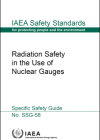Nucleonic gauges are measuring and analysis instruments exploiting the interaction between ionising radiation and matter. Industry around the world uses this technology to control and improve product quality by optimising processes and saving energy and materials.
Nucleonic gauging
Several hundred thousand nucleonic control systems are operating in industry worldwide. Since the technology has the key advantage that direct contact with the material is not needed, the instruments are particularly suited for use at high-speed production lines or systems operating at extreme temperatures.
Nucleonic control systems can be used for either static or continuous measuring applications. Some nucleonic gauges do not use radiation sources but are based on measuring the natural radiation of an examined material. Nucleonic measurement systems also allow for the visualization of internal structures of objects and flows through different technologies such as Computed Tomography (CT).
The two most commonly used gauge systems are transmission and backscatter. These systems measure the material without destroying it or changing its properties. The high-energy gamma radiation can penetrate the walls of sealed containers, which allows for material inside to be measured without opening the containers.
Most nucleonic control systems have a larger sampling volume than that of other physical techniques, which is usually also much larger than assays (analytical sampling techniques) normally collected for laboratory analysis. The systems are robust and usually versatile in their application to different materials and processes.
Technological progress, supported by the IAEA
The IAEA has contributed substantially to the development of industrial applications using the nucleonic control systems technology. As a result of significant technological progress in this field, developing IAEA Member States have been able to introduce it in a number of clearly defined industrial areas.
The nucleonic control systems technology competes well with conventional techniques in many areas. This includes such international priority sectors of industry as mining and mineral ore processing; environmental monitoring; paper and plastics industries; cement and civil engineering industries; and oil and gas industries. As the benefits in these sectors are sizable, new applications and techniques used in the design, calibration, quality control and operation of the technology is on-going.
Several IAEA Member States have established national groups that have the capacity to sustain and further develop the nucleonic control systems technology. There is indeed a need to continue stimulating, maintaining and building consulting capability in interested developing Member States, and, where appropriate, support and train teams of skilled specialists to look after the nucleonic control systems used in their industries. They need to calibrate and check the safety of the used applications and to advise local industries on the selection and development of appropriate nucleonic control systems from a techno-economic point of view.





